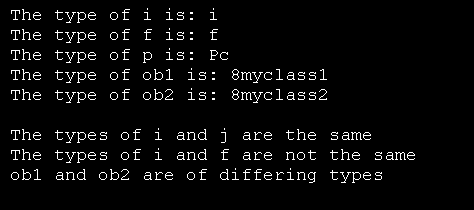Here is a simple example that uses typeid

#include <iostream>
#include <typeinfo>
using namespace std;
class myclass1 {
};
class myclass2 {
};
int main()
{
int i, j;
float f;
char *p;
myclass1 ob1;
myclass2 ob2;
cout << "The type of i is: " << typeid(i).name();
cout << endl;
cout << "The type of f is: " << typeid(f).name();
cout << endl;
cout << "The type of p is: " << typeid(p).name();
cout << endl;
cout << "The type of ob1 is: " << typeid(ob1).name();
cout << endl;
cout << "The type of ob2 is: " << typeid(ob2).name();
cout << "\n\n";
if(typeid(i) == typeid(j))
cout << "The types of i and j are the same\n";
if(typeid(i) != typeid(f))
cout << "The types of i and f are not the same\n";
if(typeid(ob1) != typeid(ob2))
cout << "ob1 and ob2 are of differing types\n";
return 0;
}
Related examples in the same category